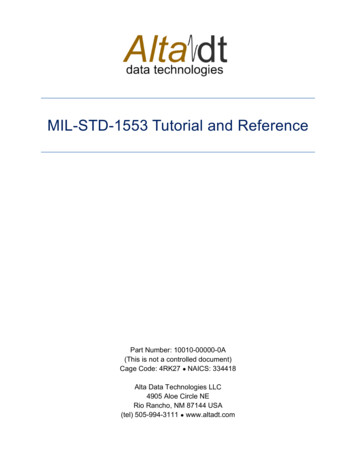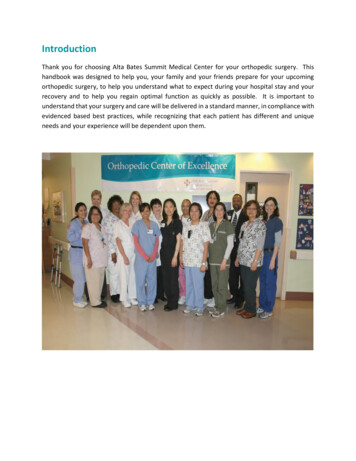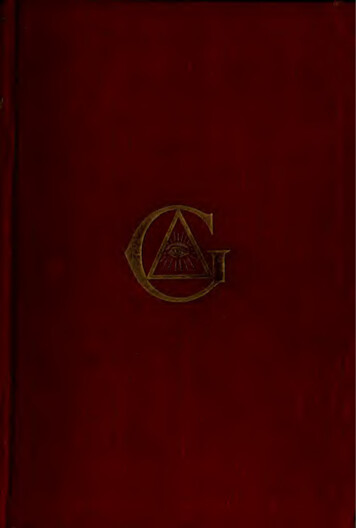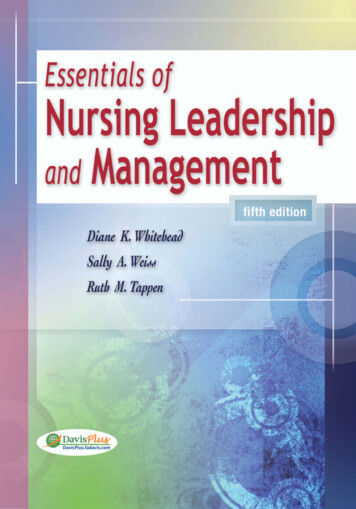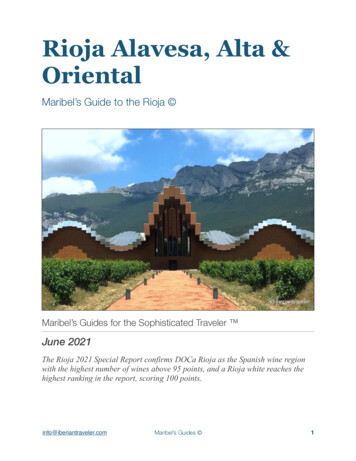
Transcription
Rioja Alavesa, Alta &OrientalMaribel’s Guide to the Rioja Maribel’s Guides for the Sophisticated Traveler June 2021The Rioja 2021 Special Report confirms DOCa Rioja as the Spanish wine regionwith the highest number of wines above 95 points, and a Rioja white reaches thehighest ranking in the report, scoring 100 points.info@iberiantraveler.comMaribel’s Guides 1
IndexThe Rioja Wine Region - Page 3Picturesque Villages Of The Rioja - Page 5Planning Your Visit - Page 8Getting to the Rioja - Page 12Where To Base Your Stay - Page 16Rioja Wine Classi cations - Page 18Rioja Alta & Alavesa - Page 20 Haro - Page 21 Haro’s Barrio de la Estación - Page 28 Briñas - Page 37 The Tirón Valley - Page 41 Anguciana Ternero Sajazarra Fonzaleche Cuzcurrita de Río Tirón Tirgo Castañares de Rioja Ollauri - Page 56 Gimileo- Page 63 Briones - Page 66 Castillo de Davalillo - Page 71 San Asensio - Page 72 The Najerilla Valley - Page 80 Hormilleja Uruñuela Nájera Badarán Cordovín Arenzana de Abajo Baños de Río Tobía-Bañuelos Baños de Ebro-Mañueta - Page 95 Torremontalbo - Page 101 San Vicente de la Sonsierra - Page 104 Santa María de la Pisciña - Page 115 Labastida - Page 116 Ábalos - Page 122 Samaniego - Page 130 Villabuena de Álava - Page 138 Páganos - Page 148 Laguardia-Biasteri - Page 153 Elciego - Page 172 Lapuebla de Labarca - Page 182 Cenicero - Page 193 Laserna - Page 201 Barrio El Campillar - Page 205 Fuenmayor - Page 207 Logroño - Page 217 Oyón-Oion - Page 226 The Iregua Valley - Page 232 Alberitefiinfo@iberiantraveler.com Entrena Nalda Elvillar de Álava-Bilar - Page 241 Lanciego-Lantziego - Page 247 Yécora-Iekora - Page 252 Barriobusto - Page 255 Labraza - Page 257 Moreda de Álava - Page 259Rioja Oriental - Page 262 Murillo de Río Leza - Page 264 Galilea - Page 268 Alcanadre - Page 271 El Villar de Arnedo - Page 273 Arnedo - Page 277 Quel - Page 280 Tudelilla - Page 283 Aldeanueva de Ebro - Page 286 Alfaro - Page 295 Grávalos - Page 300La Navarre Rioja Alta - Page 302 Navarra de Aras - Page 304 Bargota - Page 306 Mendavia - Page 308 Cárcar - Page 313 Andosilla - Page 315 San Adrián - Page 318 Azagra - Page 321 Cadreita - Page 324La Ribera Baja de Navarra - Page 326 Corella - Page 328 Cintruénigo - Page 333 Murchante - Page 337 Cascante - Page 340 Ablitas - Page 343 Barillas - Page 346Beyond The Wine - Page 349 Casalarreina Ezcaray Santo Domingo de la Calzada Anguiano Camero Nuevo and La Demanda Los CamerosThe Monastery Route - Page 359Route Of The Dinosaurs - Page 362Travel Planning Services - Page 364Maribel’s Guides 2
The Rioja Wine RegionNo adventure in Spain would be complete without a visit to Spain's oldestand best known wine region, considered the "benchmark" of Spanishwinemaking. The Rioja is a stunningly beautiful and ancient landinhabited since the Neolithic era where you’ll nd atmospheric fortresstowns sitting on a hill, some with their medieval walls still intact and lledwith Noble homes displaying heraldic shields. There are enormous Gothicchurches, each with its own amazing, ornately gilded Baroque altarpiece,but seldom seen, because these churches are kept tightly shut other thanfor mass. Ancient burial markers (dólmenes), scattered about the eldsand vineyards, intermix with the wineries; traditional, boutique and thelarger, industrial wineries. Here is where you’ll also nd a number offi3fifiMaribel’s Guides fiinfo@iberiantraveler.com
charming family run country inns, along with superb Riojan and Basquecuisine.Proposed for inclusion in the UNESCO World Heritage Listing in 2013, it’sthree distinct sub-zones make up the wine-producing region of Spain’soldest DO - the Rioja Alta, whose capital is Haro, the Rioja Alavesa, thatsection of the Rioja in the southern portion of the province of Álava, theBasque Country, the smallest of the three sub-zones, and the RiojaOriental (formally known as the Rioja Baja), the majority of which lies inthe dryer and much hotter southeastern portion of the Rioja, and is thelargest sub-zone. A section of southern Navarra also belongs to the RiojaDenomination de Origen, as does a small area of Castile y Leon, on thewestern edge of the Rioja Alta.There are 144 municipalities in the DOCa Rioja; La Rioja, Navarra and PaísVasco (Basque Country), with 16,686 winegrowers in the Rioja DOCa,Spain’s largest, with some 65,726 hectares of vineyards currently underharvest. It used to be that the Rioja Alavesa, with 13,000 hectares ofvineyards under production and nearly 400 wineries, and the Rioja Alta,covering the western portion of the Rioja, with most of the vineyards ofits 580 wineries lying south of the Ebro River, held the most interest forwine tourism, as they produce some of the area’s most expensive andvenerable wines, boasting the most prestigious wineries in the region, butthat has now changed somewhat with the introduction of some newwineries in the Rioja Oriental, an area that accounts for 40% of the wineproduction in the Rioja.info@iberiantraveler.comMaribel’s Guides 4
Picturesque Villages Of The RiojaSome of the most picturesque villages can be found following the route ofthe wine from Haro to Logroño, a journey of some 50 kilometers. Thereare fewer villages along the road from Logroño to Alfaro, depending onwhich route you follow; the shorter 75 km route through Calahorra, or theslightly longer route on the north side of the Ebro River, in La RiberaNavarra, that will take you through Lodosa, known for its famous piquillopeppers, and San Adrián, with it ancient monastery dedicated to SanAdrián y la Virgen de la Palma.If you follow the route from Haro to Logroño, we recommend visiting thefollowing historic towns along the way; Briñas, noted for its manymansions formerly inhabited by Haro’s wine nobility. Labastida, thehistoric Basque village and impressive fortress town, which celebrates theinfo@iberiantraveler.comMaribel’s Guides 5
traditional 17th-century dances to the Christ Child during Christmas.Briones, one of the most atmospheric and unspoiled villages in the Riojasits adjacent to the impressive Dinastia Vivanco wine museum, and justacross the Ebro River from its former enemy, San Vicente de la Sonsierra,which celebrates Holy Week with a fascinating Maundy Thursdaycelebration followed by the Good Friday procession of “Los Picaos”, oneof the best known and most important Holy Week processions in all ofSpain. In San Vicente be sure to drive up to the top of the village to theSanta María la Mayor church for wonderful views of the area and of thecastle of Davalillo lying just to the north of the small village of SanAsencio. We also recommend visiting the sleepy and tiny wine villages ofÁbalos, home to a dozen small wineries and Samaniego, another winemaking hamlet lled with mansions of warm, golden stone.Back in the Rioja Alavesa, there is Villabuena de Alava, home to anastonishing 33 wineries, including two of our favorites, Bodega de laMarquesa (Valserrano) and Bodegas Luis Cañas, and the architecturallycutting-edge, 4-star Hotel Viura. Our very favorite village in Álava remainsLaguardia, the forti ed bastide town and capital of the Rioja Alavesa.And nally there is Elciego, where the Frank Gehry-designed hotelcomplex for Marqués de Riscal, the Ciudad del Vino, was inaugurated inSeptember, 2006, which put the region rmly on the international winetourism map.You can pick up a brochure of the ‘Rioja Alavesa Wine Route’ at thetourist o ce in Laguardia at Calle Mayor, 52. The o ce opens daily at10:00 am, 10:45 am on Sundays. It will provide you with an excellentdriving tour of these villages. Or if you begin your visit to the region fromLogroño, be sure to pick up the available brochures and booklets at thefifififfififfiMaribel’s Guides info@iberiantraveler.com6
Tourist O ce of La Rioja, Calle Portales, 50, open weekdays at 9:00 amand at 10:00 am on weekends.Some of the historic towns along the way from Logroño to Alfaro, in theRioja Oriental, include: Agoncillo, with it’s medieval castle Aguas Mansas,Cornago, in the Alcarama Mountains, with its 12th-century castillo deCornago, the mountain village of Quel, with its birthplace of Bretón de losHerreros, one of the most important and proli c comic playwrights of the19th-century. There is also a 15th-century castle, currently underreconstruction. The Bread and Cheese Festival in Quel, a 541 yeartradition, runs every year from August 4 10. Arnedo, a 20-minute drivesouthwest of Calahorra, is one of the most prosperous towns in the Rioja.It has a defensive forti cation dating from the time of the Moors, andcelebrates a one-week long festival in late September, Las Fiestas de SanCosme y San Damián, that you shouldn’t miss if you’re in the area.The Michelin Regional Map #573; Basque Country-Navarra-La Rioja, isvery detailed and extremely helpful when planning your route to andfrom the three sections of the Rioja. Some maps of the Rioja Alta do notinclude the Basque villages, just as maps of the Alavesa region sometimesforget their Rioja region cousins, which can be a bit confusing to the rsttime visitor.7fi-fiffifiMaribel’s Guides info@iberiantraveler.com
Planning Your VisitWhen to come? Although the Rioja can be a year round destination, forthe best weather and the most scenic beauty, you should plan your visitfrom either early April through May or from September through lateOctober. The vibrant fall colors will be at their most spectacular followingthe harvest, usually around the rst or second week of October. Mostwineries in the Rioja now o er guided tours, and all but a few require youto schedule a visit in advance. Most tours are conducted in Spanish, a fewin French, and some o er at least one, if not two tours a day, in English,particularly those wineries in and around Haro, Laguardia and Logroño,which has been thoroughly discovered by English speaking visitors. Besure to request a tour in a language you are most comfortable with.Visiting hours are normally restricted; some are open in the morningonly, and nearly all will be closed during lunch (1:30 to 4:00 pm). ManyMaribel’s Guides fiffffinfo@iberiantraveler.com8
wineries now have an online booking request detailing visiting hours andavailable languages. Trying to do a “on-the- y”, à la California’s NapaValley, the “Wine Ghetto” in Lompoc, or hitting the Urban Wine Trail inSanta Barbara, is all but impossible.For several years the area was slowly changing, adapting its mind set withthe opening of amboyant "designer" wineries designed by world classarchitects or “starchitects” to attract larger scale wine tourism such asSantiago Calatrava's striking pavilion designed for Bodegas Ysios, the overthe-top Frank Gehry designed Marqués de Riscal City of Wine, BodegasBaigorri by Basque architect Iñaki Aspiazu Iza, and the dramatic andenormous Bodegas Campo Viejo by Ignacio Quemada which sits in thehills outside Logroño. But most wineries in the Rioja remain strictly nononsense business operations, not set up for massive wine tourism likemany their counterparts in the sherry region of Jerez de la Frontera, orthe cava growing region of northeast Spain, the Penedès in Catalunya.At one time it was di cult, but not impossible, to visit three wineries onyour own on any given day. All you needed to do was to make the rstreservation as early as 9:30 or 10:00 am, the second between noon and1:00 pm, then scheduling the last visit after 4:00pm, making sure that thethree wineries are in close proximity of each other as most tours andtastings take at least 90 minutes. But now, with the advent of Wine Bars,you can reasonably visit as many as four bodegas in one day, and have arelaxing lunch if you plan your day carefully. Just note that here stillremains a language issue in areas outside of Haro, Laguardia, Logroñoand Alfaro.Maribel’s Guides 9fiflffiflinfo@iberiantraveler.com
and tasting, scheduling two tours per day, one for mid to late morningand one around noon. You can then add a stop at one of the new winebars where you can do a tasting without a tour of the cellar and/orvineyard, before enjoying a leisurely lunch Riojan style. And remember,most shops will be shut down until after lunch. And if possible, we alsorecommend using a car and driver service as you will be tasting severaldi erent wines at each bodega, as many a ve in one tour, sometimesmore, depending on who is giving the tour.There are some small guided group tours you can join that take no morethan 5 or 6 people. Or, if you are a larger group of 8 or 10, then they canarrange a special tour for you. Please note that because of the pandemic,wineries have reduced the number of people they will allow for a tourand tasting, and some have stopped allowing visitors altogether. If you areplanning on doing most of the touring and tasting on your own, and willbe in the Rioja for a few days or more, then you should consider goingwith a small group for at least one day during your stay, preferably therst day.Three days in either the Rioja Alavesa, Alta, or the Rioja Oriental, will giveyou time to visit several wineries in the area but we think ve days ineither the Alavesa, Alta or Oriental is optimum, allowing you to alternatewinery visits with cultural tours and enjoy this uniquely beautiful wineregion.Hotels can arrange some tours but don’t rely entirely on your hotel stato do this for you is you have something special in mind, and particularlyif you plan on traveling in or around harvest time or during the very busyMaribel’s Guides ff10fififiinfo@iberiantraveler.comfffiIf this is your rst time in the Rioja, we recommend doing a private tour
summer season. And please note that during the hectic harvest seasonsome of the small, family-owned wineries may not open for visits at all,although the “major players”, such as Marqués de Riscal, Bilbaínas, Muga,CVNE, López de Heredia, Ysios, Finca Valpiedra and LAN will continue toprovide tours. Some wineries will even allow you to join the harvest for afew hours.We have put together a pro le of the 286 bodegas in 66 villages in theRioja Alavesa, Alta, Oriental and Navarre Rioja Alta, plus 13 more in 6villages in the Ribera Baja de Navarra that we consider interesting andworth visiting. We haven’t been to all of them ourselves as yet, but havevisited a large number over the last twenty years. Not all of the bodegasare open to the public, but you will be able to visit the vast majority listedon the following pages, each unique in their own way.Very few wineries o er a complimentary visit. The cost of a standard tourand tasting can be as low as 8 to 10 , or as high as 30 , while premiumtours and tasting can be well in excess of 100 .If you don’t have the time or desire to plan your own tour, to do theneeded preparation, then you can put yourself in the hands of IberianTraveler, as we are superbly well-equipped to help arrange your entirevisit to the Rioja and provide you with an excellent, informative Englishspeaking local guide.fiffinfo@iberiantraveler.comMaribel’s Guides 11
The view looking south across the vineyards near Ábalos, La RiojaGetting To The RiojaArriving by car from MadridThe drive from Madrid to Logroño normally takes about 4 hours withoutstops if you are taking the A1/E5 north past Burgos. It’s a few minutesshorter if you take the E 90/N 111 through Soria and the Cameros, which ismore scenic. If you are driving to the Rioja on the A1/E5 from the AdolfoSuárez Madrid-Barajas Airport after an a long international ight, werecommend stopping overnight in Burgos or at the Parador de Lerma. Ifyou are taking the E 90/N 111 from the airport, then you can stayovernight at the Parador de Soria.The drive from Madrid to Alfaro in the Rioja Oriental usually takes lessthan 4 hours, but if you are driving from the Adolfo Suárez MadridMaribel’s Guides 12fl----info@iberiantraveler.com
Barajas Airport after an international ight, you should considerovernighting at the Parador in Soria, or take a slight detour and spendyour rst night in Spain in Sigüenza, at the Castle of the Bishops, theParador de Sigüenza.Arriving by car from BarcelonaIf driving from Barcelona, the quickest route would be to take the AP 68,which will take you directly into Logroño. Since the drive is a little over 5hours without stops, we recommend you take a lunch break beforereaching Alfaro in the Rioja Oriental, either in Tudela (Navarra) atRestaurante Treintaitrés or Trinquete Restaurante. If you want to take ashort detour to Cintruénigo, then you can have lunch at RestauranteMaher. In Alfaro, we recommend Graccurris, Morro Tango or San RoqueAsador.When driving from Barcelona, we normally spend the night at the ACHotel Ciudad de Tudela so we can explore the city, see what’s new. TheHotel Aire de Bardenas, located outside of the city, is also a good option,especially if you have a couple of days and want to explore the BardenasReales.Arriving by car from San Sebastián-DonostiaIf you’re staying in sophisticated, stately San Sebastián, you can follow thehighway to Bilbao, turning south toward Haro as you reach the city, orhead toward Pamplona on the A 15, and south on the A 12. Followingeither route will take about 2 1/2 hours, but the route through Navarrawill take you to Logroño and then Laguardia, after passing throughNavarra’s major wine producing region, starting just south of Pamplona.13-fl--fi-Maribel’s Guides info@iberiantraveler.com
Arriving by car from BilbaoThe Basque Country’s vibrant city on the coast is just over a one hourdrive from the Haro, in the Rioja Alta wine producing region, and about1 1/2 hours from either Logroño, capital of the Rioja Alta, or Laguardia,capital of the Rioja Alavesa, the Basque Country. Haro makes for a easyone-day self-guided tour, or you can take a guided tour from Bilbao withour friend Mikel of Tours by Basque if you don’t want to drink and drive.Arriving By BusThe Alsa Bus runs from Madrid at Avenida de América, or from theAdolfo Suárez Madrid-Barajas Airport, Terminal T4 to Logroño. Ticketsare 24,76 one-way. The trip takes 4 hr 15 min from the airport or or 4 hr5 min from Avenida de América with three stops. There are twodepartures/day, Monday-Saturday, at 8:00 am and 3:00 pm.Bus service between Bilbao (Termibus) and Haro or Logroño is o ered byCuadraBus with at least 4 departures/day. The trip takes a little over onehour to Haro and 1 hr 45 min to Logroño. The cost is between 6 and 10 ,one-way. The bus also stops in Labastida, Ábalos, Samaniego andLaguardia.Arriving By TrainMost visitors to the Rioja arrive by car but there is currently a traindeparting Madrid daily at 12:30 pm, arriving in Logroño at 4:35 pm andone in the afternoon departing at 6:15 pm, putting you in Logroño at 9:42pm. There is also a daily departure from Barcelona Sans Station at noonthat will get you into Logroño at 4:35 pm, with a second train departing atMaribel’s Guides 14ff-info@iberiantraveler.com
3:30 pm, getting you to Logroño at 7:36 pm. See Renfe or Petrabax (USA/Canada) to book your tickets.Flying to the RiojaThe closest international airport to the Rioja Alavesa and Alta is Bilbao(BIO). The smaller regional Logroño-Agoncillo airport in Logroño, thecapital of La Rioja, only handles Air Nostrum and Iberia ights to andfrom Madrid and Barcelona, plus private aircraft. Taxi service is availableat the airport; Radiotaxi ( 34) 941 222 122. There is a supplement of0.49 /bag if carried in the trunk.The Zaragoza (ZAZ) is the closest international airport to Alfaro, a littleover a one-hour drive. The airport is serviced by Air Europa, BinterCanarias, Iberia, Ryanair, Volotea, Vueling, Wizz Air. Taxi service isavailable at the airport; Radio Taxi Aragón ( 34) 976 383 838, Radio TaxiCooperativa ( 34) 976 757 575 and Radio Taxi Zaragoza ( 34) 976 424 242.Maribel’s Guides 15flinfo@iberiantraveler.com
Hotel de Ábalos, La RiojaWhere To Base Your StayWhile the temptation exists to choose a base in a city, and the provincialcapital of Logroño does have many charms, if you come to the region bycar, we strongly suggest that you base yourself in the countryside in oneof the charming medieval stone villages, some of which are surroundedby vineyards, so you can experience the real avor of this enchantingland. There are several options to choose from depending on the type ofaccommodation you’re looking for. They range from a 5-star luxuryproperty to a more modest Casa Rural.If you need to rely on public transportation, then Logroño is your onlypractical choice. Although the city itself doesn’t exude the feel of a wineMaribel’s Guides flinfo@iberiantraveler.com16
town, that all changes during the Festival of San Mateo on September 21when the wine harvest festival begins and the city bursts with merriment.You can join in the fun of daily parades, outdoor lunches of grilled babylamb chops, bull ghts, concerts and reworks, but be sure to book yourhotel far in advance of the festival.If you must have easy access to large scale shopping and some nightlife,yes, then choose Logroño. But if you can do without dance clubs, tapasbars at your beck and call and you enjoy communing with nature, drivingthrough vineyards, then you will be happier staying outside the city anddo as we do; spend the early evening in Logroño’s historic quarter,especially along the famous Calle Laurel dining on tapas, then return tothe country for a restful night’s sleep. Remember, this is farming country,so it tends to be rather quiet after 10:00 pm except during esta.Maribel’s Guides 17fififiinfo@iberiantraveler.com
Bodegas Gómez CruzadoRioja Wine Classi cations Joven - Is fresh, young table wine, designed to be consumed today. Crianza - Wine aged a minimum of one year in an oak cask and up to 12months in the bottle. They are quality wines meant for every daydrinking. Reserva - Spends at least one year in oak casks and is aged a minimumof two years in the bottle. Gran Reserva - An exceptional vintage having spent two years in oakcasks followed by at least two years of aging in the bottle. Espumosos de Calidad de Rioja - Is the new sparkling ��s Guides 18
New Zonal Classi cationsLike the wines of other Spanish regions, Rioja wines have long beencategorized based strictly on their aging times, which has made sensegiven the wonderfully long and vibrant shelf-lives of many of this region’sfamous Reserva and Gran Reserva wines. However, for the past couple ofyears, DOCa Rioja has encouraged a shift in its classi cation system,placing new emphasis on the speci c terroir and geographical origins of agiven wine, a move that highlights the diversity that can be found in asingle region due to di erent soils, microclimates and vineyard location,among other factors.The o cial changes to the DOCa Rioja wine classi cation system tooke ect on January 1, 2019 giving both producers and consumers more toolswith which to de ne and di erentiate their favorite Rioja wines- longconsidered some of the world’s nest. Vino de Zona – grapes grown in the zone, vini ed and aged at thewinery in the zone. Vino de Municipio – grapes grown in municipality. Viñedo Singular – wines long established single estate vineyards withthe wine made and bottled on the estate.fififififffffififfifffiMaribel’s Guides info@iberiantraveler.com19
Fall colors in the vineyards around Haro, capital of the Rioja AltaWine Touring in the Rioja Alta & AlavesaWe usually start our wine touring in Haro when in the western end of theRioja. Haro, the wine capital of the Rioja Alta, is an agricultural town ofjust under 12,000 inhabitants and has the largest concentration ofcenturies-old wineries in the world; CVNE, Gómez Cruzado, BodegasBilbaínas, López de Heredia-Viña Tondonia, Martinez Lacuesta, andCarlos Serres. Many of the notable wineries are located to the north,below the main part of the town in the Barrio de la Estación, also knownas the Barrio de las Bodegas, near the railway station, where free parkingis available. A few other wineries are located south and to the west of thecenter of Haro and also provide parking. Note, parking in Haro, especiallyaround the old quarter, can be di cult.Maribel’s Guides ffiinfo@iberiantraveler.com20
Ayuntamiento de Haro, city hall, in the Plaza de la PazHaroWe usually start our wine touring in Haro when in the western end of theRioja. Haro, the wine capital of the Rioja Alta, is an agricultural town ofjust under 12,000 inhabitants and has the largest concentration ofcenturies-old wineries in the world; CVNE, Gómez Cruzado, BodegasBilbaínas, López de Heredia-Viña Tondonia, Martinez Lacuesta, andCarlos Serres. Many of the notable wineries are located to the north,below the main part of the town in the Barrio de la Estación, also knownas the Barrio de las Bodegas, near the railway station, where free parkingis available. A few other wineries are located south and to the west of thecenter of Haro and also provide parking. Note, parking in Haro, especiallyaround the old quarter, can be di cult.Maribel’s Guides ffiinfo@iberiantraveler.com21
Other than visiting the wineries, there are some importance monumentsyou might be interesting in seeing, such as the late Gothic-style Parroquiade Santo Tomás, the Church of Saint Thomas, located in the old quarter atPlaza de la Iglesia, 7. It’s also known as the “Watchtower” as the tower isthe highest point in the city. The 18th-century Basilica de La Virgen de laVega and the Museo Virgen de la Vega, which opened in 2002, face thePlaza Marqués de Francos and the Vega Gardens. El Museo del Torreón,the 15th-century Tower of Prisoners, which now houses the Museum ofContemporary Art (closed on Mondays) is on Calle at the entrance to thePlaza de la Paz. The Museo al Aire Libre is a series of sculptures oftraditional, artisan and artistic trades you’ll nd while walking around thecity. The Palacio de Bendaña, a great example of the Plateresque stylearchitecture, ornate decorative facades covered with oral designs, datesfrom the 16th and 17th centuries, is part of the old city wall, and whereyou will nd the tourist o ce, facing the Plaza de la Paz. The 18th-centurybaroque-style Palacio de las Bezaras, built of ashlar stone, also know asthe Stork Palace, is at Calle Vírgen de la Vega, 16, a couple of minutes walkfrom the Plaza de la Paz. The Palacio de los Condes de Haro is a 15thcentury palace, an interesting mix of Renaissance and Baroque styles, sitsnext to Parroquia de Santo Tomás at Plaza de la Iglesia, 3. Haro’s BretónTheater is named for Manuel Bretón de los Herreros, poet and one of theSpain’s most important and proli c comic playwrights of 19th-century. Hewas born in the village of Quel, in the Rioja Oriental, in 1796. Market daysare Tuesdays and Saturdays.The Rioja Wine Interpretation Center at Bretón de los Herreros, 4, hasbeen expanded, modernized and re-named La Estación Enológica deHaro, and merits a visit. It’s housed on three oors, and the tour starts onflflfiffififiMaribel’s Guides info@iberiantraveler.com22
the second oor, where the entire process of wine cultivation isexplained. On the rst oor the main features of the wine making processcan be seen. The ground oor illustrates the character and characteristicsof the Riojan villages and its people and their close relationship to theworld of wine.The two-day Carnaval del Vino, the Haro Wine Carnival, is celebratedbetween late February and late March every year (you’ll have to check thedate depending on the year). Tickets will be available at both the Haroand Logroño tourist o ces. The annual Batalla del vino, the Battle ofWine, takes place on June 29 during the festivals of San Juan, San Felicesand San Pedro. La Cata del Barrio de la Estación, the Haro Station WineExperience, was scheduled to take place on June 19, 2021 beginning at11:00 am, but has been delayed until 2022. You will need to purchase yourtickets online.Haro at lunchtimeSave for festival days, Haro can be a rather sleepy place after the sun goesdown with the exception of the area of La Herradura, the horseshoeshaped tapas circuit, where you’ll nd some of the town’s popular tapasbars; Bar Beethoven at Calle Santo Tomás, 3, Talia at Calle de SantoTomás, 21, los Berones at Calle Santo Tomás, 28. Bar el Pasadizo is atPlaza de la Iglesia, 1, los Caños is at Plaza San Martín, 5 and El Risqueñoat Plaza San Martín, 3. Bar El Remolino is at Calle San Martín, 2, and BarBeethoven III is at Plaza de la Iglesia, 8.Located in a recently renovated space next to Café Suizo at Juan GarciaGato, 2, at the entrance to the Plaza de la Paz, Alboroque de Haro is thenew addition to the ne gourmet dining scene in Haro by chef Raúl MuñizMaribel’s Guides fiflflffifififlinfo@iberiantraveler.com23
and his wife Laura. Around the plaza you will also nd El Rinconcito deCai and Bar Benigno. The legendary asador Casa Terete can be found atLucrecia Arana, 17, one block up from the Plaza de la Paja. GastrobarSeñorío de Haro has opened in a new space at Calle Lucrecia Arana, 4,across the street from Casa Terete. For a decent GinTonic, Teorema is justdown the street at Calle Ventilla, 1. It’s been around since 1981.Staying In HaroThere are a few good options for staying in the area beginning with the18th-century, 4-star Eurostars Los Agustinos, a building with 600 yearsof history. The 19th-century palace, the 3-star Hotel Arrope, wascommissioned by the Duke of Moctezuma de Tultengo, a descendant ofthe Aztec Emperor Moctezuma II is located at Calle Virgen de la Vega, 31.The 16 room Hotel Plaza de la Paz, in the Plaza de la Paz, is also a goodoption for those staying in Haro.Haro Wineries Of Interest Ramón Bilbao Carlos Serres Bodegas Manzanos Haro Bodegas Martinez LacuestaRamón BilbaoRamón Bilbao Murga from Etxebarri opened his bodega in 1924, today hiswinery has 265 hectares of its own vineyards; 60 hectares in
wine tourism, as they produce some of the area’s most expensive and venerable wines, boasting the most prestigious wineries in the region, but that has now changed somewhat with the introduction of some new wineries in the Rioja Oriental, an area that accounts for


